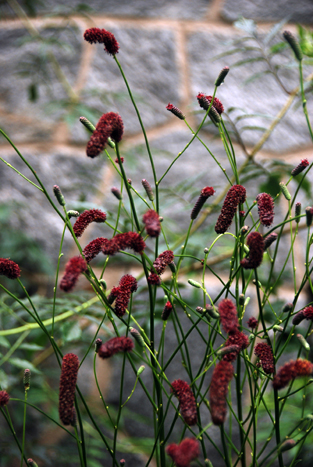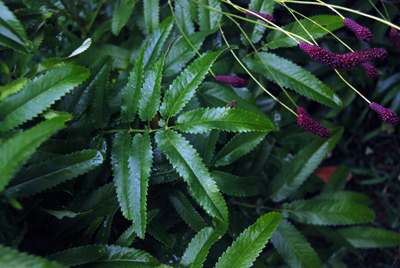Sanguisorba tenuifolia 'Purpurea'

The Japanese burnet is a plant that I have only observed on a few occasions, but it has always left a lasting impression. Lately I have been admiring a planting of Sanguisorba tenuifolia ‘Purpurea’ near the Sproul Terrace steps. Its burgundy red flowers bobbing in the air are hard to miss. The size of this plant is not overwhelming, even though the foliage reaches a substantial four feet in height. The bulk of this plant’s body remains close to the ground, consisting of long compound leaves in a basal arrangement. If you do not want to focus on flowers, one can emphasize the continuity of seasonal interest, as the burnet’s pinnate foliage is a major asset. The compound leaves are concentrated near the ground and slowly ascend, culminating in late summer with burgundy flowers atop long scapes. The edge of each leaflet has a very pronounced serration, which gives the collective foliage an intricate texture.

Sanguisorba tenuifolia 'Purpurea' photo credit: S. Keitch
The burnet’s clusters of inflorescences form an elongated spike, which are more upright in comparison to other Sanguisorba species. Many consider the three-inch inflorescences to be whimsical in habit. The flowers often capture the movement of wind and appear to float in the air. The purple form will bloom for most of August, and well into September. Deadheading can prolong this period, but the spent flower heads are also attractive. Sanguisorba tenuifolia should be grown in full sun with moist soil with sufficient drainage. Partial shade is tolerated but the bloom will not be as profuse.

Serration on the leaves of Sanguisorba tenuifolia 'Purpurea'. photo credit: S. Keitch
Personally, I love naturalistic gardens where large flower size and obnoxiously bright colors are not the highest priority. I do not mean to say that I don’t love bright gardens with bold color combinations, but that I rather enjoy the subtlety of “wild” gardens. To me, the burnet epitomizes this style and possesses naturalistic qualities, which might otherwise be lost if planted out of context.





eileen
Posted at 13:28h, 14 Januaryyou don’t want to be without these flowers for floral arrangements; they add whimsy, filler and good architecture; just put up with the thug like nature, plant between a rock and a hard place.
Don Pell
Posted at 10:12h, 06 JanuaryI was wondering if anyone knows how long lived Sanguisorba tends to be in the midatlantic?
Andrew Bunting
Posted at 08:49h, 07 JanuaryDon,
We had this for several years in a garden in full sun with good drainage at the Arboretum, but we did lose it eventually. I suspect that good drainage is a key.
Andrew